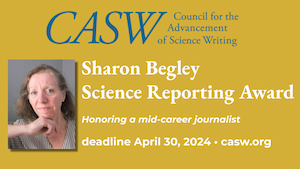THE WORLD CONFERENCE OF SCIENCE JOURNALISTS. Our much-vaunted Western science comes by its bragging rights legitimately, but let's take a moment to remember that it's based in some part on long-ago science from the Middle East. Copernicus and Robert Boyle, among others, cribbed from the Arab scientists who got there first – often hundreds of years first.
So, even if the biennial World Conference of Science Journalists had not just finished meeting in Qatar, it is only right that WCSJ attend to Arab science. David Dobbs and Mo Costandi organized a session on that topic, and Dobbs gave a brief preview at Neuron Culture. From which I cribbed, it seems only right to mention, the above facts about scientific cribbing. Fill in your many gaps on this topic with Dobbs's reading list
The harvest of blog posts from WCSJ so far is not abundant, but perhaps attending bloggers will come forth anon, after their jet lag abates. You will be gobsmacked to learn there were, however, tweets in abundance at #WCSJ2011. The U.S. National Association of Science Writers, one of the meeting's sponsors, has a page of links to conference material. It includes the Twitter feed. Find snippets of the meeting on YouTube.
We have a record of part of the panel called "Am I a science Journalist?" because among the panelists were uber-bloggers Ed Yong and Chris Mooney, and they have shared their insights on their blogs, Not Exactly Rocket Science and The Intersection.
Pere Estupinya posted in Spanish on the panel "What Editors Want". Find it at the Knight Science Journalism Tracker. There's an English intro, which noted the barriers that non-native English speakers face when trying to break into English language pubs.
Mohammed Yahia, of the Nature network blog House of Wisdom, which is about Arabic science, wrote about the panel on how (and how not) to write about evolution. For example, say "evolution" rather than "theory of evolution," which to the general public suggests that the idea of evolution is still hypothetical.
Peter Griffin described the panel on the muzzling of government scientists at Griffin's Gadgets.
HEALTH MATTERS. Kaiser Health News has just launched a blog. Its clever name, Capsules, describes it perfectly: brief newsy items about health care. As is KHN's wont, it focuses on policy rather than medical news-you-can-use. For example, here's Andrew Villegas's piece on reaction to the appellate court ruling this week that last year's massive national health legislation is constitutional after all. Next stop, the US Supreme Court.
EVERYTHING YOU EVER WANTED TO KNOW ABOUT E. COLI. Not a blog, but in view of what's been going on in Europe, to say nothing of elsewhere, so what? A round of public-sprited applause for the American Society of Microbiology, which is making all its past publications on enterohemorrhagic E. coli available free here
TAKING STEPS TO SELL DOCS ON DRUGS. A certain amount of blogging high dudgeon – but probably not enough – has attended a paper just published in the Archives of Internal Medicine reporting on yet another stomach-churning pharma practice: conducting "seeding trials," ostensible clinical trials whose real purpose is to persuade as many physicians as possible to prescribe as much of the trialed drug as possible. The case study involved gabapentin, aka Neurontin, and the trial was called Study of Neurontin: Titrate to Effect, Profile of Safety (STEPS). (Offtopic, sorta: Is there an International Tribunal that devises and approves these Rube-Goldberg project names whose only purpose is acronymic? I'd really like to know; will somebody do a piece on this, please?)
At In the Pipeline, Derek Lowe explains why this makes him feel like spitting on the floor. As a marketing plan, the trial was quite effective, as it turns out. At Science Life, John Easton points out:
Physicians in the trial increased gabapentin prescriptions by 38 percent and dose by 10 percent. [There were 772 participating docs!] Neurologists who were not part of the trial did not increase their use of the drug.
The new blog news@JAMA carries a Mike Mitka interview with the doc who wrote the accompanying commentary, G. Caleb Alexander. He declares:
... in most cases, the types of documents we have in the Archives paper are not in the public domain. Remember that seeding trials are unethical but not illegal, and given this, it does pose challenges to the scientific community to uncover and prevent them.
Challenges to science writers too, I would think.
PRESCRIPTION FOR THE ELDERLY AND FOR LESBIANS AND GAYS. Speaking of clinical trials and prescribing practices, Laura Newman has a guest blog at Scientific American arguing strongly for much more research on the effects of prescription drugs in the elderly. Why? That age group is increasing rapidly, is underrepresented in clinical trials, and is taking more drugs than any other. And there's a lot of evidence that drugs metabolize differently and have different effects in older folks.
Newman describes the recent Food and Drug Administration safety alert warning against the high-dose version (80 mg) of simvastatin, brand name Zocor. She also describes her 92-year-old mother's painful experiences and eventual death. Her physician had prescribed the 80 mg. dose of simvastatin even though her heart disease risk was low.
While I'm up, let me also call attention to Newman's new blog PatientPOV, now in operation for a couple of months. She believes the patient perspective is neglected and has set out to remedy that, soliciting stories from patients who think they are not being heard. Her latest post, following on New York State's legalization of lesbian and gay marriage, is a call for more media attention to lesbian and gay issues, including health matters.

.png)

